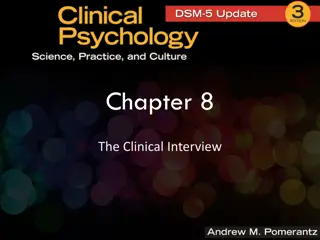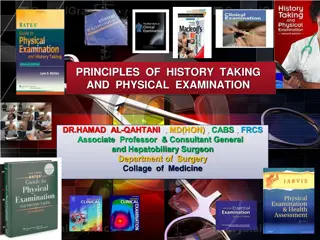Principles of History Taking in Clinical Assessment
History taking is a crucial process in patient assessment, aiding in determining the etiology of medical issues. Obtaining an accurate history through proper questioning, active listening, and maintaining a professional appearance is vital for making accurate diagnoses. The history should follow a structured order including personal data, present complaint, history of present complaint, systemic inquiry, past medical history, family history, and social history. By adhering to principles such as establishing rapport, asking open-ended questions, and paying full attention to the patient, healthcare providers can effectively gather essential information for diagnosis and treatment planning.
Download Presentation

Please find below an Image/Link to download the presentation.
The content on the website is provided AS IS for your information and personal use only. It may not be sold, licensed, or shared on other websites without obtaining consent from the author.If you encounter any issues during the download, it is possible that the publisher has removed the file from their server.
You are allowed to download the files provided on this website for personal or commercial use, subject to the condition that they are used lawfully. All files are the property of their respective owners.
The content on the website is provided AS IS for your information and personal use only. It may not be sold, licensed, or shared on other websites without obtaining consent from the author.
E N D
Presentation Transcript
Principles of History Taking Dr Thamer Bin Traiki
History Taking A process of gathering information during patient interview as part of patient clinical assessment.
Importance Obtaining an accurate Hx is the critical 1ststep in determining the etiology of a patient s problem . A proper history and examination will get you to your diagnosis almost 70% of the time .
Set Up Your appearance is important (wearing proper uniform, ie. Lab coats, I.D., etc.) Your way of asking the Qs See him walking in and not in the cubicle & allow a relative to be there if the patient wants. Provide a safe & private environment
Cont.. Introduce yourself Greeting patient By name Shake hands Avoid unfamiliar or demeaning terms Be alert and pay him full attention
The way of getting the Hx Ask open questions Listen carefully Take notes Avoid interruption except Special situations
History should be in the following order : Personal data Present complaint (c/o). History of present complaint. Systemic enquiry. Past history: surgical, medical , drug history Family history Social history
Personal Data Date and Time Name & File number ( Medical record number) Age Gender Religion Marital status Occupation Residency Who gave the history?
Chief Complaint Present complaint or problems : Symptom/Symptoms that caused patient to seek care and their duration . In the patient s own words If multiple , list them in order of severity . Chief complaint may be misleading Problem may be more serious than the chief complaint
History of the presenting Illness Elaborate the symptom in medical terminology Provides full clear, chronological details of the history of the main problem/s . Previous similar attack/s should be included here . What had been done for the patient if any Elaborate the system involved. Add any related symptoms .
Systemic Review Negative symptoms are as important as positive one. You have to ask about them all, and keep repeating them in each patient, to memorize them well.
Neuro Nervousness Excitability Tremor Fainting attacks Blackout Loss of consciousness Changes of smell, Vision or hearing Muscle weakness Paralysis Sensory disturbances Paraesthesiae Headaches Change of behavior Fits
Cardiovascular & Resp Cough Sputum Haemoptysis Dyspnoea Hoarseness Wheezing Chest pain Paroxysmal nocturnal dyspnoea Orthopnea Palpations Dizziness Ankle swelling Pain in limbs Walking distance Temperature and color of hands and feet
GI Appetite Diet Abnormal Taste Dysphagia Odynophagia Regurgitation Indigestion Itching Vomiting Haematemses Abdominal pain Abdominal Distension Bowel habit Melena PR bleeding Jaundice
Urogenital Loin pain Symptoms of uremia Headache Drowsiness Fits Visual disturbances Vomiting Edema of ankles, hands of face Lower urinary tract symptoms ( LUTS) Painful micturition Polyuria Color of urine Hematuria Male Infertility history Sexual history
Musculoskeletal Aches or Pain in muscles, bones and joints Swelling of joints Limitation of joints movements Weakness Disturbance of gait
Constitutional symptoms: Weight loss/gain Fever Night sweats
Past Hx. Childhood illnesses Adult illnesses Accidents and injuries Surgeries or hospitalizations Blood transfusion Drugs : Insulin, Steroids and OCP Allergy to any medications or food
Family Hx Health of immediate family father , mother , 1stdegree relatives HTN, DM , heart disease, contagious illnesses Potential for hereditary diseases
Social Hx Detailed marital status Living accommodation Occupation Travel abroad Leisure activity Smoking Drinking Eating habits
Sensitive Topics Alcohol or drug use Physical abuse or violence Sexual issues
Sensitive Topics Guidelines Respect patient privacy Be direct and firm Avoid confrontation Be nonjudgmental Use appropriate language Document carefully Use patient s words when possible
Special Challenge Silence Overly talkative patients Patients with multiple symptoms Anxious patients Limited intelligence Crying Anger and hostility Intoxication Depression Confusing behavior or histories Developmental disabilities Language barrier
Cont.. False reassurance May be tempting Avoid early reassurance or over reassurance Unless it can be provided with confidence
Common surgical symptoms Pain Lump Ulcer
Pain Hx 1. Site 2. Time & mode of onset 3. Duration 4. Severity 5. Nature ( Character) 6. Progression of pain 7. The end of pain 8. Relieving factors 9. Exaggerating (Exacerbating) factors 10.Radiation 11.Cause
Visceral pain Visceral peritoneum is innervated bilaterally by the autonomic nervous system. The bilateral innervation causes visceral pain to be midline, vague, deep, dull, and poorly localized. Visceral pain is triggered by inflammation, ischemia, and geometric changes such as distention, traction, and pressure. ( usually the result of distention of a hollow viscus ).
Embryologic origin of the affected organ determines the location of visceral pain in the abdominal midline. Foregut(stomach to the second portion of the duodenum, liver and biliary tract, pancreas, spleen) , present as epigastric pain. Midgut (second portion of the duodenum to the proximal two thirds of the transverse colon) pain present as periumbilical pain. Hindgut (distal transverse colon to the anal verge) pain present with suprapubic pain.
Parietal pain Parietal peritoneum is innervated unilaterally via the spinal somatic nerves that also supply the abdominal wall. Unilateral innervation causes parietal pain to localize to one or more abdominal quadrants . Sharp, severe, and well localized. The anterior and lateral abdominal wall is innervated from vertebral segments T7 to L1, whereas the posterior abdominal wall is from L2 to L5.
Parietal pain : Triggered by : Irritation of the parietal peritoneum by an inflammatory process (e.g., chemical or bacterial). Mechanical stimulation, such as a surgical incision.
Referred pain Arises from a deep visceral structure but is superficial at the presenting site i.e. pain felt at a remote area from the diseased organ . It results from central neural pathways that are common to the somatic nerves and visceral organs i.e. misinterpretation of visceral afferent impulse that cross the nerve cells to the corresponding somatic dermatome within the CNS .
Radiating pain is pain in remote area but in continuity with the diseased organ .
Lump & Ulcer When did u notice it ? How did u notice it? What are the associated symptoms ? Persistence ( does it ever disappear ?) Progression ( change in its size ) Any other lump currently or previously What do u think the cause ?























